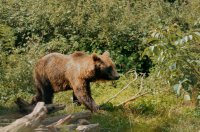Kitovras
Kitovras is an ancient Russian name for centaur. This creature entered Russian culture around the 14th century and you can learn about its adventures in apocryphal legends, where it’s portrayed as an antagonist to the biblical king Solomon. It’s an extremely wise creature that constantly competes with the king.
According to one of the legends, Solomon needed its help to build the Temple in Jerusalem, as Kitovras knew how to find a magical tool that helps cut stones; so, Solomon tricked the centaur, captured it, and made it share the secret. Once the construction was over, Solomon teased the centaur about its defeat but Kitovras punished the king for being too proud and magically sent him to a faraway land.
Rusalka
Rusalkas are nowadays associated with mermaids – half-women, half-fish. However, this image was brought to Eastern Slavic folklore from Western Europe and became especially popular around the 19th century, when classic authors like Alexander Pushkin and Mikhail Lermontov started to use it in their works. Until then, rusalkas weren’t perceived as beautiful women with fish tails who tried to charm and trick men. In ancient folklore, they were young girls who suffered an untimely death. Looking like regular people, these dangerous spirits didn’t necessarily live in the water and were known to gather at night.
Alkonost & Sirin
Half-human, half-birds, these creatures appeared in Russian folklore in the Middle Ages – the oldest known images of Sirin were created as early as the 10th century.
Alkonost is a magical bird inspired by the Greek myth about Alcyone, a girl turned into a bird by gods. According to Russian legends, it lays eggs into the depths of the sea around the winter solstice. During the first seven days after that, the sea remains calm. The songs of this bird make you forget everything else.
Another anthropomorphic bird, Sirin – possibly inspired by sirens – is related to Alkonost and they’re often portrayed together. They both sing hypnotizing songs but Sirin’s voice is sad, whereas Alkonost’s singing is happy – an idea most vividly represented in a famous painting by Viktor Vasnetsov.




